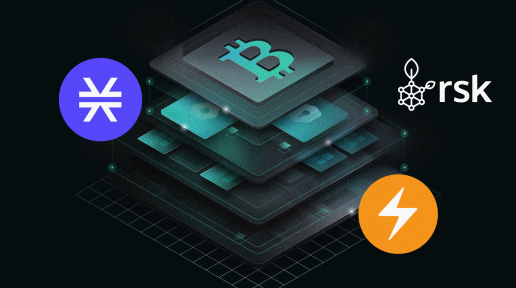Building on the Bitcoin blockchain has marked a mix of unique opportunities and challenges throughout its 15 years. Unlike other blockchains, Bitcoin’s proposal was to just be a store of value and payments system. But as Ordinals and BRC-20 tokens have shown us, Bitcoin has the potential to be so much more. However, to fully realize this potential, Bitcoin needs a robust base infrastructure that can offer both security and scalability. That’s where scaling solutions like Layer 2 blockchains come into play.
Layer 2 solutions help unlock Bitcoin’s latent capital through a layered architecture similar to Ethereum's network. Users can enjoy faster transactions and interact with more complex applications on Bitcoin L2s.
In this article, we’ll look at the adoption of the three key L2 solutions in the space — Lightning network, Stacks, and RootStock. We’ll also dive into the key challenges Layer 2 solutions face and what the future looks like for them.
Adoption Metrics of Major L2s in 2024
Lightning Network
The Lightning network is one of the most widely used Layer 2 solutions, enabling faster and cheaper transactions for BTC micropayments. Major companies like McDonald's and Walmart use the Lightning Network as their backend to allow quick Bitcoin payments. Similarly, Bitcoin exchanges like OKX and Binance have also seen substantial cost savings by integrating the Lightning Network for inter-exchange transfers, user withdrawals, etc.
More importantly, these integrations have expanded access to the Lightning Network, providing over 300 million users with faster and more economical Bitcoin transactions. As of September 2023, River estimates about 279K to 1 million wallets are actively using the Lightning network with about 6.6 million in transactions. This puts the 2-year growth trajectory of the network at a remarkable 1212%, up from the 501k transactions in August 2023.
Apart from the use cases mentioned above, verticals like gaming, social media tipping, and streaming are also quickly gaining interest, responsible for over 27% of the total transactions. With innovations like RGB set to introduce Lightning-compatible stablecoins, the overall growth premise of the L2 network looks promising.
Stacks
Second on our list is Stacks — the Layer 2 solution that brings smart contract functionality to Bitcoin built in 2017. Stacks is a developer favorite, as the #1 Web3 project on Bitcoin for two consecutive years.
Applications built on Stacks are seeing steady growth. For instance, after the launch of a popular BRC-20 order book called ALEX B20, DEX volumes rose by over 50% on the network. Similarly, the amount of capital locked on the Stacks network has also grown from 7 million to over 50 million, at the time of writing. Part of this success is due to the SEC-compliant STX token, which allows users to earn passive Bitcoin rewards and secure the network.
2024 is an exciting year for Stacks with planned upgrades such as sBTC and Nakamoto advancing DeFi on Bitcoin.
RootStock
With a TPS of 300 transactions per second, Rootstock is a Bitcoin sidechain that is EVM-compatible. What that means is that you can essentially use any Ethereum application on Bitcoin. RSK is a game-changer since it directly reduces development time and efforts while promoting interoperability.
Currently, the RSK sidechain has over 70,000 active accounts and 40+ protocols building on it. Sovyrn, a DeFi protocol built on Rootstack, has processed over $2billion in trades. This user activity indicates a growing adoption of the Rootstock protocol as a whole. Rootstock also regularly runs builder grants for developers on Rootstock, offering upto $2.5 million in funding.
Layer 2 adoption — Key Challenges
One of the core challenges while building a Layer 2 solution is the fear of centralization. Users must trust the sidechain and its associated bridge to be secure and reliable. However, since Layer 2 solutions are still nascent, its parent company and other institutional players often control a large share of their nodes. Layer 2 solutions must address this issue to gain wider adoption across the crypto community.
Plus, when it comes to adoption, wallets and other user-facing infrastructure are very important. However, it’s just not there yet. Native lightning wallets (i.e ones that aren’t integrated in other tools) are difficult to set up and operate. Bitcoin wallets like Leather have reduced this complexity to a great extent, but there’s still a lot of work to do.
Another significant obstacle to Layer 2 adoption lies in interoperability. Achieving seamless communication between different Layer 2 solutions and even Layer 1 blockchains is often problematic. While Rootstock is one of the solutions to this problem, the blockchain space desperately needs to establish standardized protocols and improve interoperability solutions.
What’s Ahead for Layer 2 Solutions?
Layer 2 solutions drive functionality, utility, and innovation across the Bitcoin network. By significantly enhancing scalability and efficiency, these solutions are furthering Bitcoin’s main ethos of financial inclusion and decentralization.
The growth of Layer 2 solutions is a testament to Bitcoin’s growing economy. As user-friendly infrastructure continues to improve, it's expected that more individuals will embrace and actively participate in the Layer 2 ecosystem.

